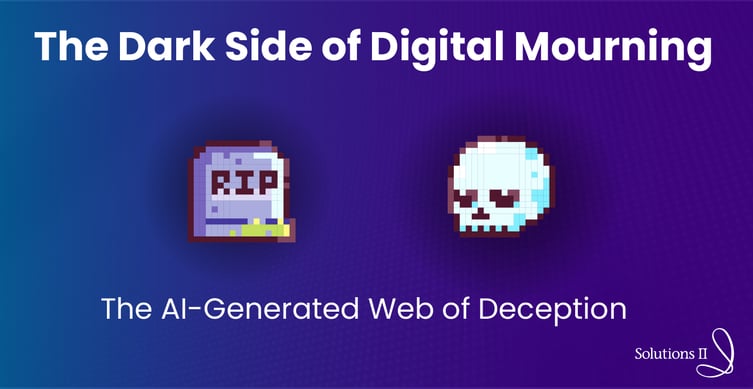The digital landscape, with its potential for connection and remembrance, has a lurking shadow side. Cybercriminals have been exploiting online memorials by creating false obituary websites. This happens when a legitimate site has a really difficult to detect - counterfeit counterpart.

While it's known that such threats exist, the recent AI-assisted false obituary of Colin Day, Solutions II’s VP of Services, brings this issue back to the forefront. An AI tool was utilized to plagiarize an existing obituary but added in an incorrect identity (photo and LinkedIn biography information) for our own VP of Services, Colin Day, who is very much alive.
The Anatomy of the Scam
Scammers meticulously design fraudulent websites to mirror the look and feel of legitimate ones. A counterfeit counterpart not only imitates the design of the legitimate site but also uses AI to create false narratives and obituaries. These sophisticated scams are particularly dangerous as they seamlessly blend lies with the truth, trapping the unwary in schemes of spreading malware or false donation solicitations.
The AI Touch - Beyond Malware and Phishing
These counterfeit websites are carefully designed to replicate authentic platforms such as MemoriaHaven.com. The risk of such sites is twofold. First, they can serve as a vessel for malware. Clicking on an obituary link or downloading a supposed tribute video can result in malicious software infiltrating your device. Secondly, these sites may engage in phishing by soliciting donations for funeral expenses or charities, preying on the empathy of mourners. The addition of SSL certificates to these fake sites adds a layer of perceived legitimacy, making the scam more convincing.
The dangers extend beyond traditional malware and phishing; the advent of AI adds a new layer of deceit. The fake obituary of Colin Day is a prime example of how AI can be misused to craft a fake obituary or utilize a legitimate obituary for someone with the same name but adding an incorrect photo and details of someone who has not passed. This adds a layer of complexity to the already dangerous landscape of cyber fraud. This capability to generate plausible yet entirely false pages presents a new challenge in cybersecurity.
While it's challenging to track the full extent of AI-generated obituary fraud, the trend is on an upward trajectory. The experience of Solutions II’s Colin Day underscores the calculating nature of these AI-assisted scams and the pressing need to address them within our cybersecurity frameworks.
Protecting Yourself and Your Organization
Defend yourself and your organization by exercising due diligence. Evaluate the authenticity of obituary notices and approach donation requests with caution. Organizations must fortify their defenses and educate employees about the potential for AI to fabricate such elaborate hoaxes.
As we continue to embrace the digital world, we must also brace for the sophisticated threats it harbors. The case of Colin Day at Solutions II is a wake-up call to the realities of AI-driven cyber threats. Let's commit to safeguarding our online memorial spaces with informed vigilance and robust cybersecurity measures. To learn more about how to protect yourself and your business, visit our website at www.solutions-ii.com or follow us on LinkedIn.




Comment Form